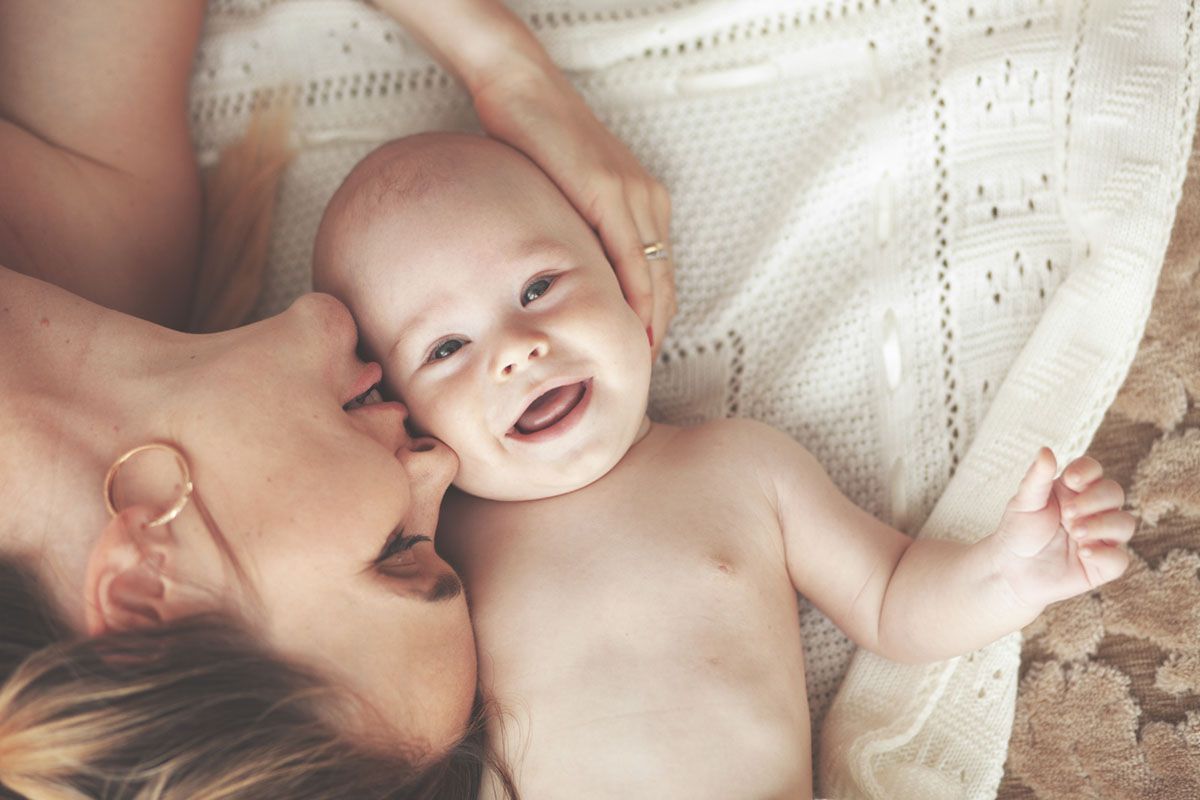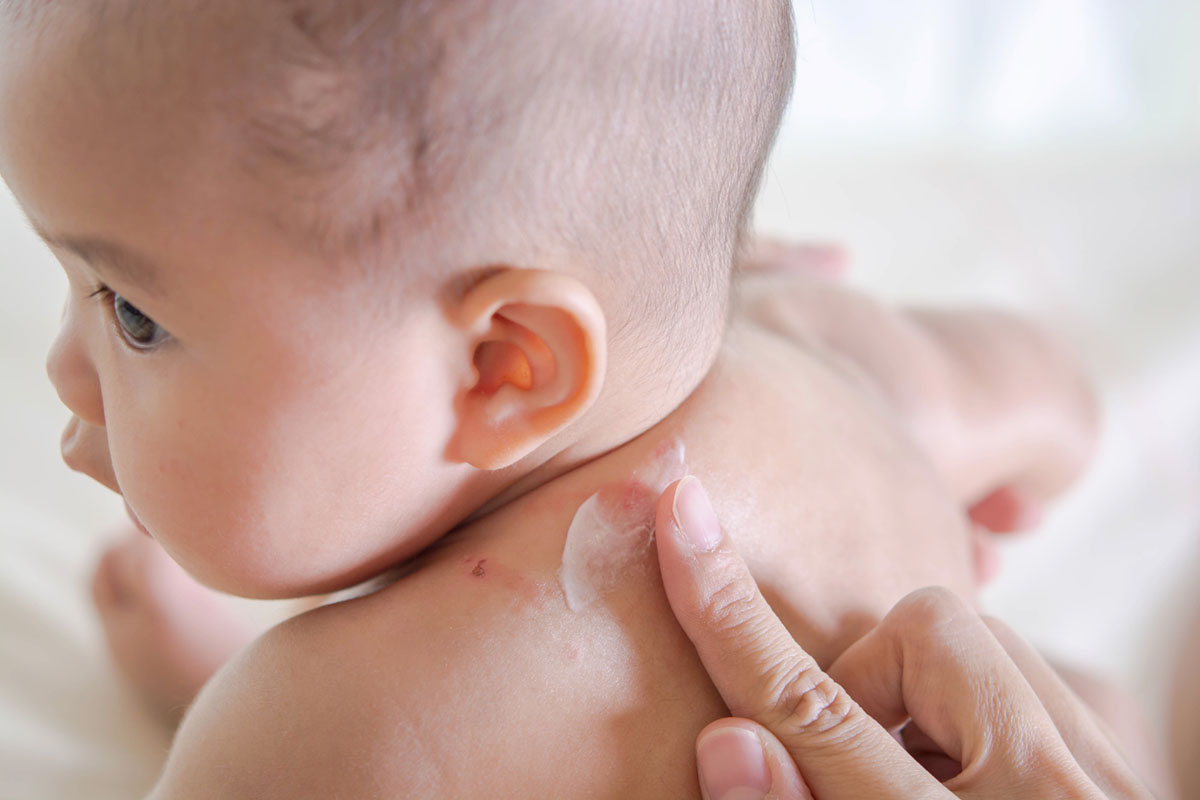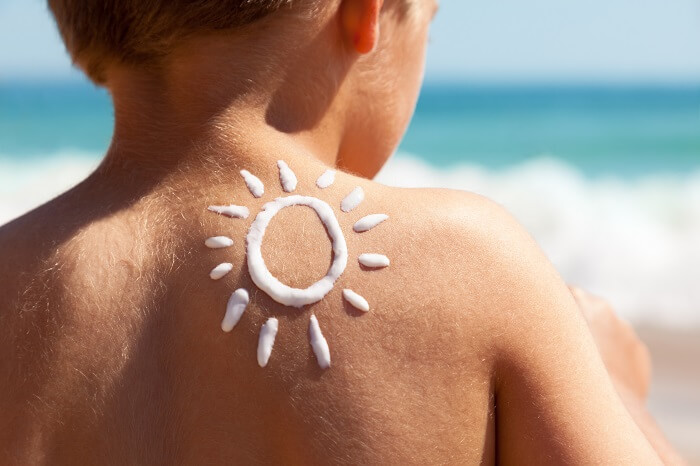Atopic Eczema in Babies
Symptoms, Causes, and Tips for Parents
Atopic eczema is one of the most common skin conditions in babies and toddlers. The intense itching, characteristic of this condition, poses a significant challenge for both children and parents.
Parents often feel helpless in this situation. However, there are several tips to help alleviate your child's symptoms.
Protection for dry baby skin
Linola Baby & Kind
A brief overview of atopic eczema
What is atopic eczema?
Atopic eczema, also known as atopic dermatitis or neurodermatitis, is a skin condition primarily characterised by dry, red, and in some cases, weeping patches accompanied by intense itching. It's a chronic inflammatory skin disease that's non-contagious and often occurs in flare-ups.
Atopic eczema often first appears in infancy or early childhood. Some individuals continue to experience symptoms into adulthood, while others may see their symptoms disappear entirely during their early years.
Atopic dermatitis often has genetic links
The skin condition atopic eczema can be inherited. If one or both parents are affected, the likelihood that their offspring will suffer from this skin condition is high. Atopic eczema often coexists with other allergic or atopic conditions.
The exact causes of atopic dermatitis remain unclear. However, research suggests that, in addition to genetic predisposition, a disruption in the skin's barrier function and an overly active immune system can play roles in the development of atopic eczema.
Symptoms in babies
What does atopic eczema look like in babies?

An early sign of atopic eczema in babies might be cradle cap. This typically forms on the face and head, characterised by skin redness and flaky crusts. It's essential to understand that cradle cap doesn't necessarily mean atopic eczema. It can be an indicator, but not every child with cradle cap will develop this skin condition.
Typical signs of atopic eczema include dry, weeping, and itchy skin changes. In infancy, atopic eczema often manifests as eczema patches, especially on the outer sides of legs and arms, as well as on cheeks and ears. If you notice such symptoms in your little one, we recommend consulting a paediatrician or dermatologist for comprehensive advice.
Confusion alert: cradle cap, infantile seborrhoeic dermatitis, and nappy rash
Some babies develop a white-yellow to brownish scaling on their scalp in the first few months. This is not cradle cap but a condition called infantile seborrhoeic dermatitis. It's entirely harmless and usually disappears on its own. Avoid scratching it off as it can hurt your baby and lead to scarring. A better alternative is to soften the crust and then gently comb it out with a baby brush.
It's also not uncommon for babies to show skin rashes in the nappy area. However, these are usually not due to atopic eczema. In the case of nappy rash, the delicate baby skin reacts to the friction of the nappy, the humid-warm climate, and possibly unsuitable care products. In such cases, gentle care tailored to this specific skin need is crucial.
Symptoms in children
How do I recognise atopic eczema in children?
As the child grows, the signs and especially the affected areas of atopic eczema can change. While inflammations often appear on babies' faces, in toddlers and older children, they frequently shift to the insides of elbows and behind the knees – so-called flexural eczema. Sometimes, hands and the neck also show visibly dry skin. The bothersome itching persists throughout childhood.
With prolonged atopic eczema, the skin areas in children can thicken – known as lichenification of the skin. These areas can then appear rougher and more leathery.
The phenomenon of cradle cap, which can occur in babies, is no longer present at this age. Always pay attention to your child's skin changes and seek professional help if needed.
Symptoms of atopic eczema in later life stages
In adults and older children, atopic eczema-related skin reactions occur less on the face or head but more on the arms and legs – especially in the elbow and knee folds.
Symptoms, as in babies and toddlers, come in flare-ups and can be influenced by external factors. Sufferers usually struggle more in winter than in summer due to weather conditions. Even people without any skin condition often have drier skin during the colder months. Additionally, stress is a typical trigger for a flare-up.
Tips for parents
How can I alleviate my baby's atopic eczema symptoms?

There are several tips to help alleviate your baby's symptoms. Patience is crucial. It might take some time to figure out what truly helps your child and what doesn't.
Atopic eczema skin care for babies and children
Regular and consistent skin care typically benefits babies with atopic eczema. This so-called basic skin care includes daily moisturising with a suitable cream or lotion that supports the skin's protective barrier. When bathing or washing, use soap-free and pH-neutral cleansing products that don't further dry out the skin.
- Apply creams gently. It's essential that your child perceives the moisturising process as positive, ideally finding it soothing. After all, it will become a regular part of your daily routine together.
- Try to touch the affected areas as gently as possible and massage the healthy skin slightly. This can not only provide physical relief but also mental relaxation for your baby, potentially positively influencing the course of the condition.
- "More is better" doesn't apply to the amount of cream or lotion. Instead of applying a thick layer, it's better to moisturise several times a day with a sufficient amount. Tip: The Linola Baby & Child Rich Care Lotion forms a protective film on the skin, providing long-lasting hydration.
- Moisturise your child even when they're not showing any atopic eczema symptoms. It's crucial to regularly hydrate and nourish the sensitive skin.
- Ensure a comfortable room temperature when moisturising so your baby doesn't get cold.
- When bathing or showering, the water temperature shouldn't be too hot. Ideally, it should be between 36 to 37 degrees Celsius. Find more tips here: Bathing your baby.
- For a good atopic eczema care product, it's best to consult a pharmacy or doctor.
Precautions for atopic eczema: prevent scratching
Atopic eczema often leads patients into a vicious cycle. The damaged and inflamed skin causes severe itching. When the patient scratches, the skin becomes even more damaged. Additionally, bacteria and other pathogens can penetrate more easily, exacerbating the flare-up.
Therefore, it's crucial to prevent scratching as much as possible. While older children can be explained why they shouldn't scratch, it's more challenging with babies. However, you can put cotton gloves on your baby or use a special sleepsuit with closed hands. Also, keep their nails short.
Be understanding if your child isn't in the best mood during an atopic eczema flare-up. The itching is not only a physical but also a significant mental strain. Give your little one plenty of attention and take ample time to care for their affected skin.
Tips against itching
How to prevent itching
Many materials and tight clothing can irritate inflamed skin. Dress your child in loose-fitting cotton or linen clothing. Also, avoid making your child sweat (e.g., by wearing too many layers) as sweat can exacerbate the itching.
When bathing, use a mild shower gel and shampoo free from additives like fragrances. Also, keep bath time as short as possible to prevent skin from drying out. When drying, gently pat with a towel, avoiding rubbing.
Atopic eczema and diet
Is a dietary change necessary?

Many children with atopic eczema also have food allergies. If your child has been diagnosed with one, a specific diet and avoiding allergenic foods can alleviate symptoms. Discuss with a paediatrician or dermatologist whether a dietary change could benefit your child.
If an entire food group is eliminated due to the allergy, like dairy products, consider consulting a nutritionist to prevent potential nutrient deficiencies in your baby.
Prevention and symptom relief
A Summary of key tips for atopic eczema in babies
Atopic eczema is among the most common skin conditions in babies and children. Although this condition is non-contagious, it can come with significant discomfort, affecting the child's well-being.
It's advisable to consult a paediatrician or dermatologist if you notice signs of atopic eczema. Additionally, you can take specific measures to reduce the risk of flare-ups and alleviate symptoms. Below is a summary of essential tips that can assist you and your child:
Preventing acute flare-ups and atopic eczema in babies:
- Avoid smoking during and after pregnancy
- Protect your child from cigarette smoke
- If possible, exclusively breastfeed until the end of the fourth month
- Maintain a balanced diet
- Use care products during sun exposure or cold weather
- Protect your child from stress
Measures to alleviate atopic dermatitis:
- Treat the skin daily with an atopic eczema care product
- Promote mental relaxation in the baby through gentle strokes and massages
- Prevent scratching by using cotton gloves or special sleepsuits
- Show understanding and attention to your child
- Dress the child in loose clothing made of skin-friendly materials like cotton
- Prevent sweating
- Use mild cleaning products
- Keep bath time short and gently pat the baby dry
- Test cold compresses for acute itching
Linola Baby & Kind
For baby-soft skin
Content verified by

Content verified by: Edith Janzen
Edith Janzen has been a midwife at the Birthing Centre Bielefeld in Germany since 2012 and is a mother herself. Her areas of expertise include out-of-hospital obstetrics, prenatal care, and postnatal care. She supports numerous families from the beginning of pregnancy through childbirth to the end of the postpartum period, providing advice and assistance during this special phase of life.
Additional topics & information
All about child and baby care

Rough patches on the body – What to do about rough baby skin?
The sensitive baby skin can quickly become rough and show dry areas. There are a variety of possible causes – most of them are harmless. Here, you'll learn how to care for and soften rough skin in babies.

Moisturising Your Baby – What Matters in Baby Skin Care
To moisturise your baby or not? This question can't be answered broadly. What's certain is that baby skin is much thinner than that of adults and therefore needs special protection. Here, you'll find tips on what to consider for baby care.

Sun Protection for Babies and Children – Tips for Parents
The skin of babies and children reacts particularly sensitively when exposed to the sun without protection. Sun protection involves more than just sunscreen. Here, parents can find tips on what matters when it comes to protecting babies and children from the sun.




